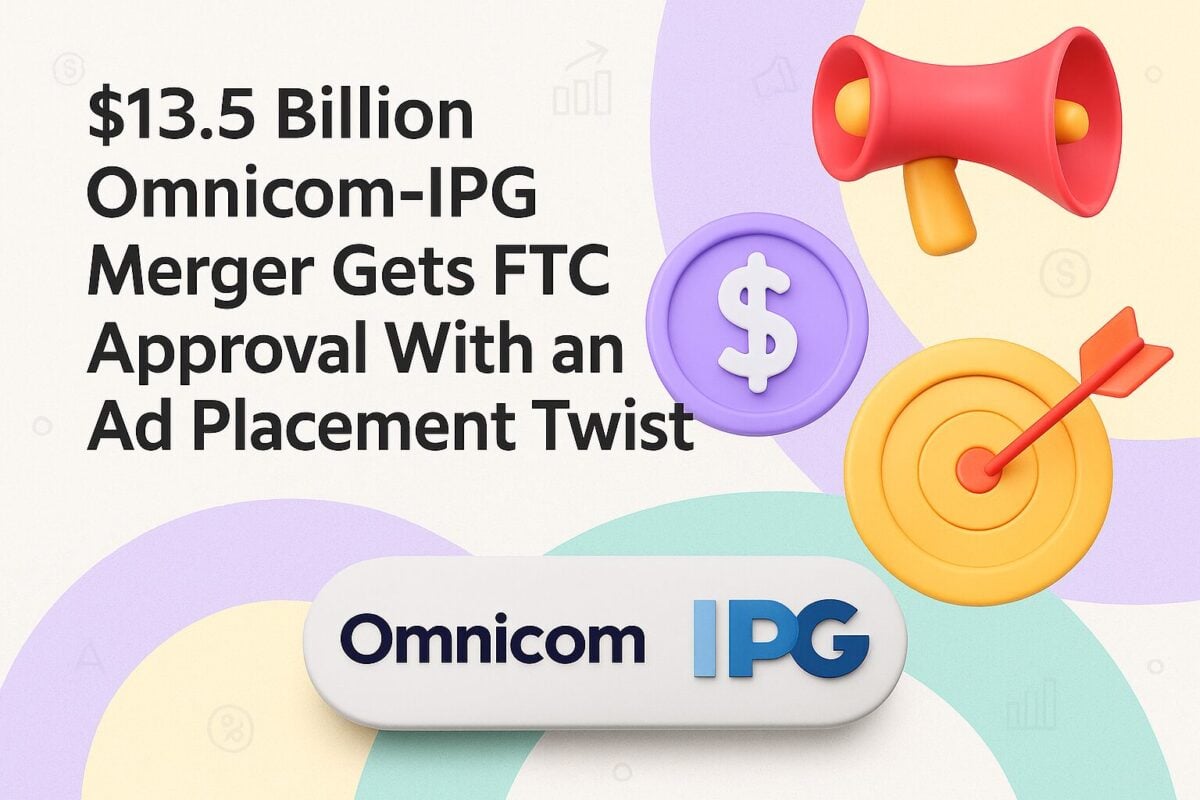A lead is a new prospect or potential customer. Therefore, lead generation is the act of increasing the number of prospects or potential customers that your sales team has to nurture. Luckily, there are a number of effective lead generation strategies that you can utilize to help you maximize your leads.
Regardless of what type of business you run, you’re always going to need new leads. These said leads typically come in the form of an email address so that you can start email nurturing campaigns that will (hopefully) eventually lead to signup or purchase.
Throughout this article, we’re going to talk about the top nine effective lead generation strategies that can help you build up a wealth of interested prospects and start nurturing them into becoming customers.
Effective Lead Generation Strategies to Implement:
1. Optimize Your Website
The first step is to ensure you have a website that is optimized for collecting high-quality leads. This means a few different things:
- Make sure you have a speedy load time
- Create a mobile responsive website
- Ensure your website is easy to navigate
- Include CTAs (calls-to-action) in high-traffic areas
Building out a fast-loading, mobile responsive, easy-to-use website reduces bounce rates and increases time spent on page. And the longer someone is on your website, the more they’re going to learn, and the more likely they are to sign up for an email newsletter or lead magnet.
You don’t want to bombard your website visitors with CTAs, but placing them in a few opportune places is key. Some of those include:
- At the bottom of your blog home page
- In the sidebar of every blog post
- On a pop-up that appears when someone first lands on your website or is about to leave your site
- On your most important sales pages
Take a look at this signup form on the sidebar of influencer marketing software GRIN’s blog:
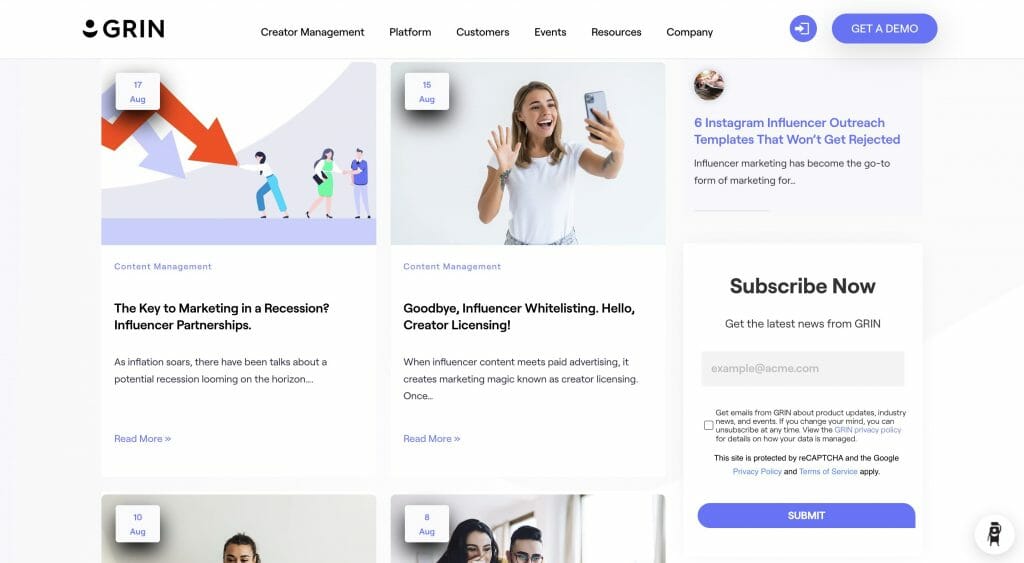
Source: grin.co
These CTAs should be something really basic. For example, you might want a “Request a Demo” form somewhere on your website, but that’s for a qualified lead who’s very interested in your product to fill out.
These forms should be “Sign up to get updates from our blog,” or “Sign up to receive our marketing emails.” Start with top-of-the-funnel CTAs that can attract leads who may just be hearing about your business and want to learn more.
2. Put Together a Comprehensive Content Marketing Strategy
Content marketing is going to be your best friend when creating a lead generation campaign. Long-form content—whether blog content, ebooks, white papers, or even webinars and video content—is a great way to prove to potential customers that you know your stuff and are willing to prove it.
Let’s start with blog content, as that’s one of the easier types of long-form content to produce. First, build out a comprehensive content strategy utilizing SEO tools to find the best keywords for your business.
If you have writing skills, consider getting started by creating the content yourself. Otherwise, either if you’re no writer or you simply don’t have the time, hire a freelancer or work with a content marketing agency.
Once you start publishing more and more content, you’ll start to rank on search engines; people will find, read, and share your content; and you’ll be able to start generating leads. Just make sure you include a signup form alongside your blog, like we showed you in the last example.
The blog content will be the basis of your content marketing strategy, and you should continue to create and publish high-quality blog posts each week.
However, some of the more in-depth content types will be even more valuable for generating inbound leads. This includes longer pieces that require much more research and effort to create, like ebooks or white papers.
When you create an ebook or white paper with the intention of using it to generate leads, it’s called a lead magnet. There are so many different lead magnet ideas you might want to create, each with varying levels of difficulty and time required.
For example, with an ebook, you have to choose your topic, do in-depth research to make sure you cover all aspects of your title, design the book, create a promotional landing page, and start generating leads. But this is a great way to ramp up your email list and start generating a bunch of new leads.
3. Create a High-Quality Email Newsletter
Email marketing will always be an important part of any company’s marketing efforts, but creating a specific email newsletter can actually be its own great lead generation tool.
Many businesses send out a weekly or monthly newsletter with some recent blog updates or quick tips. However, these all too often aren’t strategic and were simply thrown together by someone on the marketing team because, “We need an email newsletter.”
Instead, consider how you can be extra helpful to your target customers. What would they really benefit from learning from your business? Then create a strategic newsletter around that.
One great example is The Daily Carnage newsletter from marketing agency Carney.
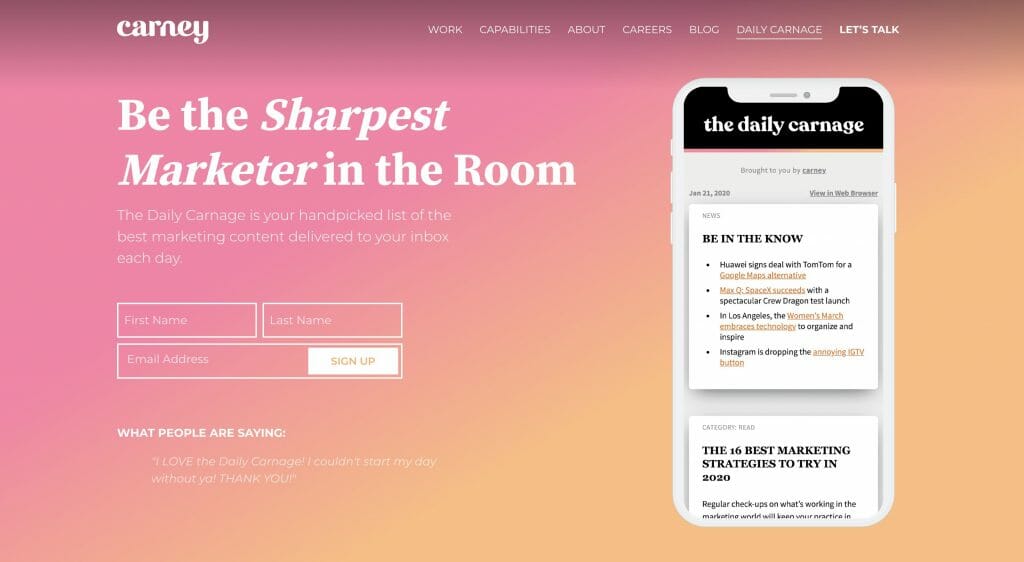
They’ve broken their newsletter down into the following sections:
- News: Recent but important marketing news
- Listen: A podcast episode that really resonated
- Read: A new blog post with help information
- Watch: A video that subscribers can learn from
And it’s super helpful information that (a) gives other marketers tools to become better at their jobs and (b) shows potential clients that they know exactly what they’re doing and would be a stellar agency to work with.
This makes for a great lead generation tool because the newsletter and its popularity speak for itself, inviting new subscribers and potential leads to sign up and learn more.
4. Build a Free Tool
This is one of the more challenging lead generation tactics in this post because you’ll either need to be or hire a developer to create the tool for you. However, it’s extremely effective, because you’re offering some sort of service completely for free—but before the user gets their end result.
Hatchful by Shopify is a great example of this. It’s a free logo maker, which makes sense as an offering for Shopify, an ecommerce storefront platform. They also have a free business name generator, though they don’t require an email before presenting business name ideas.

Source: shopify.com
With Hatchful, users are able to select the industry their business will be in, as well as the vibe they’re going for with the look and feel of their logo. Then they get to plug their business name and tagline in before viewing logo designs they can then choose and download to use for their business.
However, as soon as they click the “Download” button, they’re presented with a popup asking the user to create a free account.
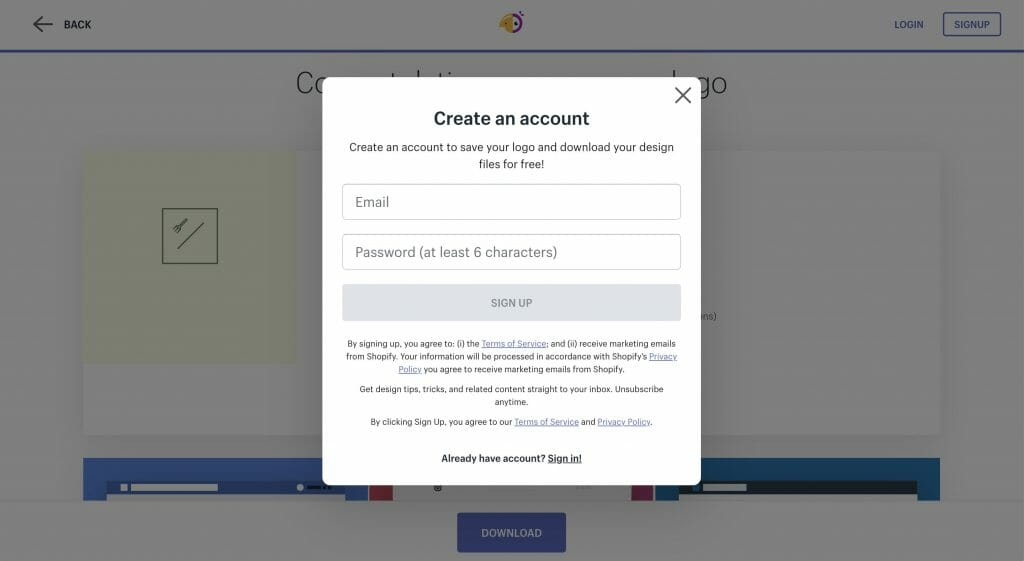
Source: shopify.com
The tool is still completely free, but they provide their email address to Shopify, and by signing up, agree to receive marketing emails from Shopify. It’s a brilliant way for Shopify to then nurture leads and entice them to create a Shopify shop or switch their existing shop to Shopify.
Another option is having a freemium tool. Users get limited access to your tool when creating a free account, but then receive regular nurturing emails that share premium features in hopes that eventually they’ll sign up for a paid account.
5. Design Landing Pages
Designing a number of landing pages is another great way to increase lead generation for your business. Many businesses have access to SEO and keyword data for a number of transactional landing pages that you can create, all with a similar layout but individualized copy.
While the idea behind a transactional landing page is to get a website visitor to make a transaction, that doesn’t always have to be the case. First, in the case of a freemium tool, it might just be to get a free user that you can nurture into becoming a paid user. In many other cases, it can just be to generate leads that you, of course, then nurture into becoming a paid user or customer.
Let’s take Visme, a graphic design tool with a freemium model, as an example. They have hundreds of similar landing pages, all with the goal of increasing free conversions that are then later nurtured into paid users.
Take this report maker landing page as an example:

Source: visme.co
This is just one of their landing pages. But if you further examine their website, there are hundreds of similar landing pages. These all have the same layout, making the process much easier on their website designer, but have completely custom copy.
Just a few other pages are:
- Chart Maker
- Ebook Maker
- Infographic Maker
- Presentation Maker
And they go on, based on pretty much any type of visual content that can be created with their design tool.
Creating landing pages—whether they’re transactional, showcase lead magnets, promote webinars or other educational resources that people need to register for, etc.—is a great way to increase the number of inbound leads your team receives.
6. Create an Online Course
Online courses are in-depth text and/or video lessons that share details on how to actionably learn how to do a certain thing. And they’re another great way to exchange educational information for an email address to add to your lead nurturing email list.
Email marketing platform Omnisend has a great example of this. In fact, they have an entire academy of video lessons along with some fully fleshed-out online courses:

Source: omnisend.com
If you decide to go this route, there are two ways to gather the contact information you need to move someone down your marketing funnel.
First, you can require them to create a free account to even access the online course material. Or, you can choose to let them take the course, but then require registration to download their certificate. The latter option leaves you less likely to get everyone’s contact information, but if you tout your course as a “certification,” people are likely to want the badge of honor for completing it.
7. Publish Case Studies
Case studies are an amazing source of social proof—they’re showcasing proven results that they’ve gotten from other clients or customers. So not only is this a great way to close sales, it helps to generate business leads in general.
There are a couple of different ways to share and promote case studies. Some companies write out case studies as a category on their blog. Others create PDFs that are on their website as gated content, requiring an email address to learn more. And some are downloadable without being gated.
Consider testing a few different options to find out what works best for your business. But regardless of whether you use this as a sales tool or a lead generation tool, case studies work wonders for your business, and you should definitely create them.
8. Promote Online Ads
This strategy is going to work hand-in-hand with some of the others here. Whether you invest in content marketing, publish case studies, build a free tool, or create an online course, you’re going to want to put some of your ad budget behind promoting it.
You may want to focus the biggest part of your ad budget behind actual sales ads and conversions, but you should absolutely set aside part of your budget to promote your lead generation tactics in order to bring in even more sales leads.
9. Publish Original Research
This last example is one of the most effective, and that is publishing original research. However, it’s also the most in-depth option on this list. If you have the resources to conduct surveys or create in-depth studies, do it.
Think of how many articles, infographics, presentations, and other online content that quote or cite original research. Think of how powerful it could be if you do the same. Not only would you generate an exponential number of backlinks, you could also generate a number of new sales leads to nurture.
Take a look at this Consumer Trends Report by consumer intelligence platform Brandwatch:
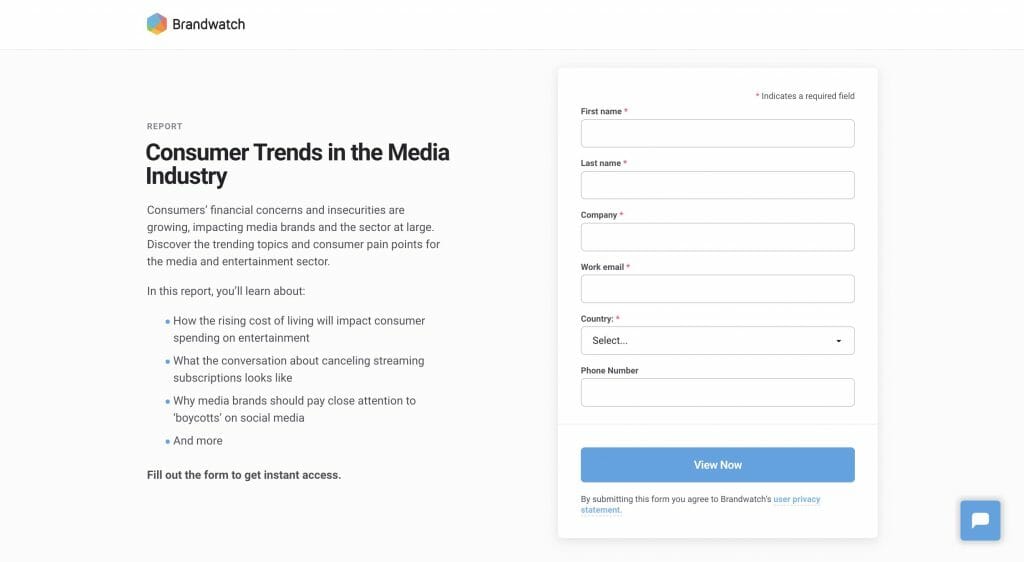
Source: brandwatch.com
Brandwatch has taken the time to create an in-depth report on trends in the media industry, and have it gated behind a signup form requiring name, company name, email address, and even country. Many of these original reports have a much more in-depth form, because they’re looking for a better quality of leads than quantity.
After all, after you’ve put that much effort into creating original research, you want to make sure it’s actually getting into the hands of potential clients or customers who might actually be legitimate buyers.
Take Advantage of These Lead Generation Strategies
Implement your favorite of these top nine lead generation strategies today and start watching qualified leads pour in. If you’re unsure of what to do once you have a CRM full of leads, learn more about creating a marketing funnel that will easily bring them down to becoming loyal customers.
Frequently Asked Questions
Lead generation strategies that work?
These are 4 lead generation strategies that work in 2023:
- Build helpful and strategic content
- Retarget website visitors with ads
- Nurture new contacts with email blasts
- Engage visitors on your website with live bot options
What are the 3 approaches of lead generation?
The three best lead generation methods include search engines, content marketing and social media marketing.
Which are the 4 steps of the lead generation process?
If your business struggles with lead generation strategy, here are 4 tips for a better lead generation process:
- Narrow down your target customers
- Create engaging content
- Increase traffic to your platforms
- Convert visitors to leads
What are the 5 types of leads?
The 5 different types of leads include:
- Potential lead
- Hot Leads
- Working leads
- Qualified leads
- Nurturing leads

